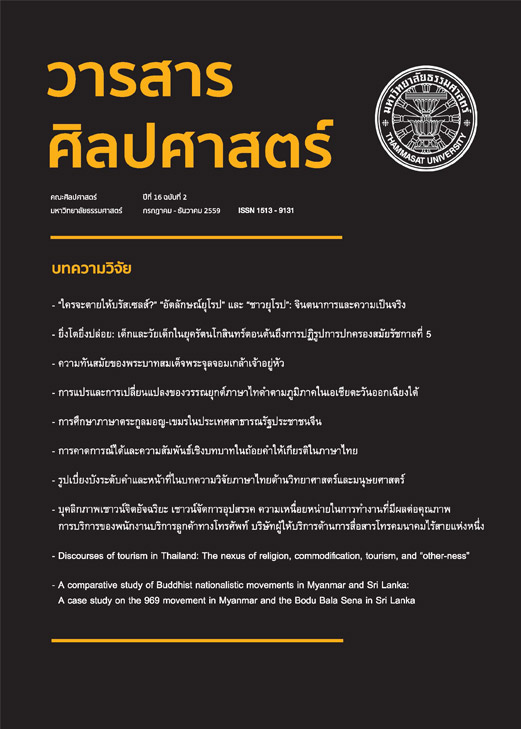การศึกษาภาษาตระกูลมอญ-เขมรในประเทศสาธารณรัฐประชาชนจีน
Main Article Content
บทคัดย่อ
ประเด็นปัญหาของงานวิจัย คือ ข้อจำกัดที่นักวิชาการไทยไม่สามารถเข้าถึงข้อมูลการวิจัยภาษาตระกูลมอญ-เขมรที่พูดอยู่ในประเทศจีนที่เขียนเป็นภาษาจีนได้ ทำให้การศึกษาเรื่องดังกล่าวในประเทศไทยมีน้อย จากการสำรวจมีเพียงการศึกษาเครือญาติของกลุ่มชาติพันธุ์ดังกล่าวที่อพยพมาตั้งถิ่นฐานบริเวณภาคเหนือของประเทศไทยบางส่วนเท่านั้น งานวิจัยนี้จึงได้กำหนดวัตถุประสงค์ในการศึกษาสองประเด็นคือ 1. การศึกษาทางชาติพันธุ์วรรณนา และ 2. การศึกษาทางภาษาศาสตร์ วิธีวิจัย ดำเนินตามวัตถุประสงค์สองข้อ คือ 1. การสังเคราะห์เอกสารแล้วนำเสนอข้อมูลทางชาติพันธุ์วรรณนา อันประกอบด้วยข้อมูลชื่อเรียก ประวัติศาสตร์ การตั้งถิ่นฐาน ระบบเศรษฐกิจสังคม ขนบธรรมเนียม ประเพณีและวัฒนธรรม 2. การวิเคราะห์โดยการเปรียบเทียบข้อมูลในเชิงภาษาศาสตร์ร่วมสมัย อันประกอบด้วยแนวคิดการจัดแบ่งตระกูลภาษาและภาษาถิ่น ระบบเสียง การสร้างคำ วงคำศัพท์ ระบบไวยากรณ์ และตัวอักษร ผลการศึกษา คือ กลุ่มชาติพันธุ์ที่พูดภาษาตระกูลมอญ-เขมรในประเทศจีนมีสามกลุ่ม ได้แก่ ปู้หล่าง เต๋ออ๋างและหว่า ตั้งถิ่นฐานอยู่ใกล้ชิดกับชาวไตและชาวจิ่งโพ บริเวณมณฑลยูนนาน จากการเปรียบเทียบทั้งประเด็นชาติพันธุ์วรรณนาและประเด็นภาษาศาสตร์พบว่ามีทั้งข้อเปรียบต่างและข้อเปรียบเหมือน ข้อเปรียบต่างชี้ให้เห็นว่าภาษาทั้งสามต่างมีเอกลักษณ์เฉพาะตัวของตนเอง ในขณะที่ข้อเปรียบเหมือนก็ชี้ให้เห็นว่าทั้งสามภาษามีความสัมพันธ์กันอย่างใกล้ชิดกันในระดับแขนงภาษา และเมื่อจับคู่ความสัมพันธ์ของแต่ละภาษาพบว่า ภาษาปู้หล่างใกล้ชิดกับภาษาเต๋ออ๋างมากที่สุด รองลงมาคือภาษาปู้หล่างกับภาษาหว่า ส่วนภาษาเต๋ออ๋างกับภาษาหว่ามีใกล้ชิดกันน้อยที่สุด
This research is about the limitation for Thai researchers to access the resources about Mon-Khmer language in China, the language which is composed in Chinese. As a result, the study of this topic in Thai research is still rarely conducted. According to the literature review, we found that some research about the ethnic groups are related with the ethnic group in China which immigrated to Thailand. The objective of this research is divided into two points: 1) The ethnographic synthesis that presents the data of name, history, habitation, social economy, traditions and culture, 2) A synchronic linguistic analysis which consists of language family and dialect, phonology, word formation, vocabulary, grammar and characters. This study found that there are three of Mon-khmer spoken ethnic groups in China namely Bulang, De’ang and Wa. They are settlements who live closely to Dai and Jingpo ethnic groups in Yunnan. According to the ethnographic and linguistics comparative study, we found both correspondences and contrastive points. The contrastive points show the singularity in each language. While, the correspondences show that each language is related with the language at the branch level. The result of language comparison shows that Bulang language is closest in terms of relationship with the De’ang language, and Wa language, was found to be the second closest. The relationship between De’ang language and Wa language is least significant.


